Casual chic: The art of looking smart without a suit
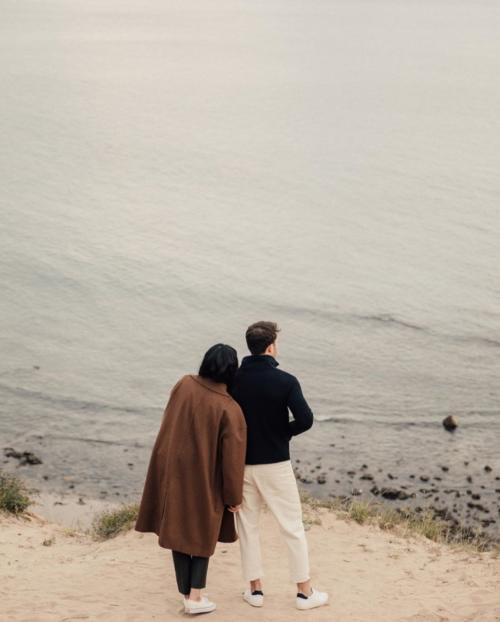
I often find there's a lot of anxiety among readers, and consultancy clients, about how to dress smartly without tailoring.
It is, of course, a topic we've addressed many times. But today I'd like to emphasise a point that’s often missed, despite being rather intuitive: that this mode of dressing has many principles in common with a suit and tie.
Casual clothing can be chic. Quality clothes in tasteful colours, well made and well fitted, will always be elegant. Indeed, often more so than a cheap or showy suit - a well-cut white shirt and linen trousers, rather than a bright-blue suit and satin tie.
This simple, casual clothing is not as objectively formal as tailoring. But then formality is a social value: it varies by industry, location and age.
Elegance, I would argue, is more permanent.
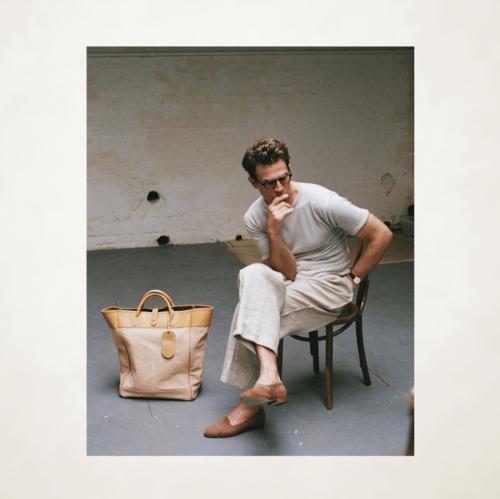
So what traits do such casual, chic clothes have? Let's run through them.
Number one, I think, is a subtlety of colour. A smart suit is dark and muted, and elegant casual clothes are no different. Navy and grey still predominate - and when other colours come in, they're similarly toned down.
If you wear an oxford shirt, chinos and a wool overshirt, they will be smartest in colours like white, navy and grey (perhaps respectively). They could also be blue, beige and olive (again, respectively) but the principle would be the same: no royal blues or acid yellows.
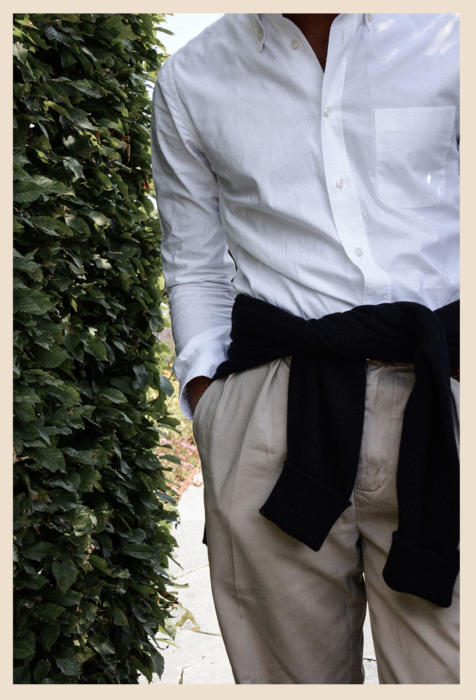
Second trait: simplicity of pattern.
Again, this is all pretty intuitive, but given how many readers ask about whether one item of clothing is smarter than another, it’s worth spelling out.
A suit is more casual, ‘sportier’, when it features a big windowpane check or a prominent herringbone. Same with casual clothing: a madras-check shirt is not as smart as a plain one.
Texture too. A knitted T-shirt is an elegant way to dress casually because its drape and smooth finish make it smarter than a regular tee. A navy knitted T-shirt worn with cream-flannel trousers is extremely elegant, yet feels a world away from a suit and tie.
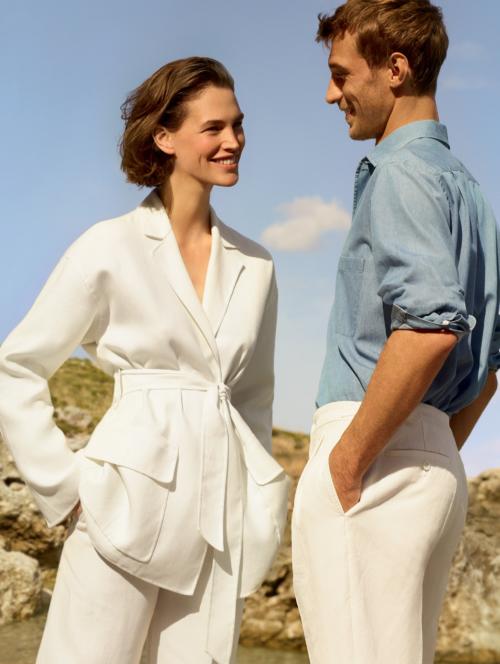
Number three is an easy one for any dedicated PS reader: the clothes must fit.
Fit might be more important than anything else when it comes to menswear, and just as important with casual elegance as with tailoring.
I regularly suggest tailored trousers as a good way to dress up in a dress-down environment, because well-fitted trousers look so elegant. Even if your shirt is all puffed out and blousy at the waist. (In fact, sometimes because it’s blousy.)
Picture trousers that run close to the seat and hips, without anywhere constraining the wearer; that run sharply and smoothly down the leg; and finish neatly just on top of the shoe. Elegance personified.
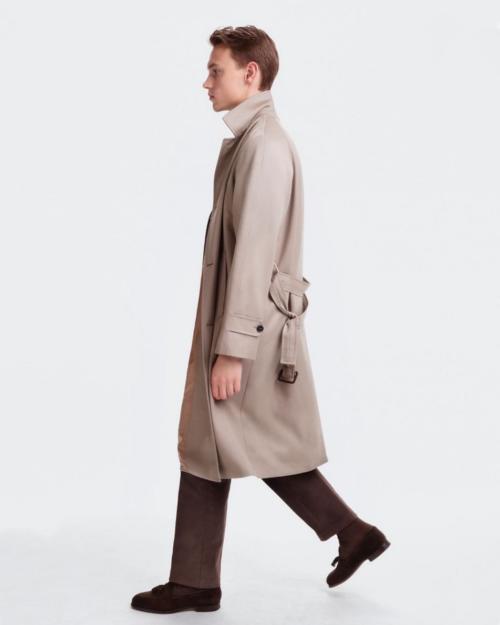
Four is quality. This is not workwear, where a coarse material like denim looks good because of its marks, patches, wear and tear.
This is the smart end of casual, and the quality must tell in the materials. A rich cashmere knit; a fine Irish linen; a well-polished shoe. They are the casual versions of a luxurious worsted suit or a lustrous tie.
Plus, casual clothing doesn’t have as much of the craft that goes into tailoring, with its hand-rolled lapels and hand-sewn buttonholes. So the materials bear more of the burden.
This often means the clothing is expensive, but arguably the way those clothes are looked after is just as important. Which brings us onto point five.
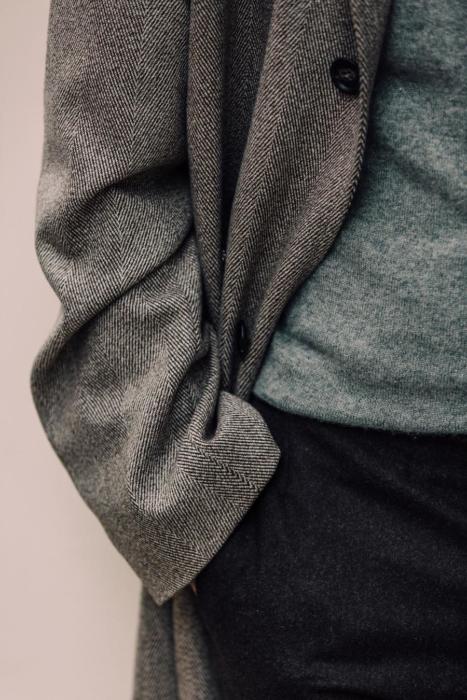
Five is less intuitive: a trait most men would not pick at all. The clothes must be clean.
Alan Flusser expresses this better than I could in Dressing The Man: "The first measuring stick for [smart] attire should be cleanliness. Clients prefer their professionals looking well groomed. Casual dressing is no excuse for looking sloppy, rumpled or unwashed."
This is an extension of knowing how to look after your clothes, and taking the time to do so.
A clean pair of pressed trousers looks much smarter than slightly soiled wrinkled ones. It's almost as important as whether those trousers are flannels, cords or jeans.
As much as I disagree with some of Alan's recommendations for casual clothing, we believe in the same principles. He concludes: "Whatever clothes you choose to wear to work, make sure they have the same characteristics you look for in a fine suit: good material, fine workmanship and excellent fit. Buy the best you can afford."
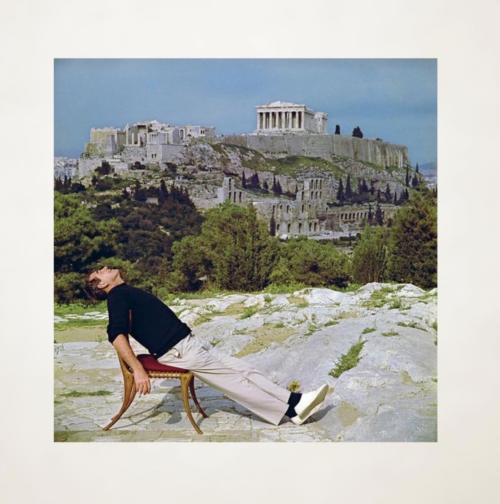
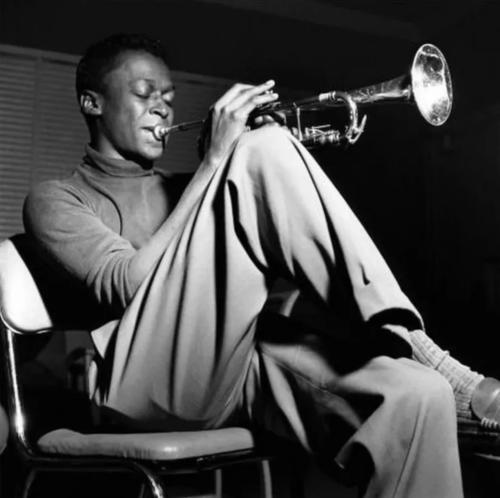
If there is a sixth point, it’s that casual-chic clothes (if we can call them that) must be worn in an unfussy manner.
A suit looks most elegant when the eye runs off it: a clean and tidy backdrop that directs the viewer up to the wearer’s face, without snagging on a patch pocket or watch chain.
Consider the archetypal Italian in summer: white shirt, cream trousers, a pair of espadrilles and a navy sweater over the shoulders. He doesn't really exist, but that doesn’t matter: he’s a useful model.
A key aspect of his elegance is appearing effortless. Whether it is or not is irrelevant (ref. sprezzatura). The point is that there is no obvious affectation - no clothes that are too loud, or trying too hard.
There is grace. Indeed, a dictionary definition of elegance says it all: “The quality of being graceful and stylish in appearance or manner; pleasingly simple and neat.”
Be simple, and neat.
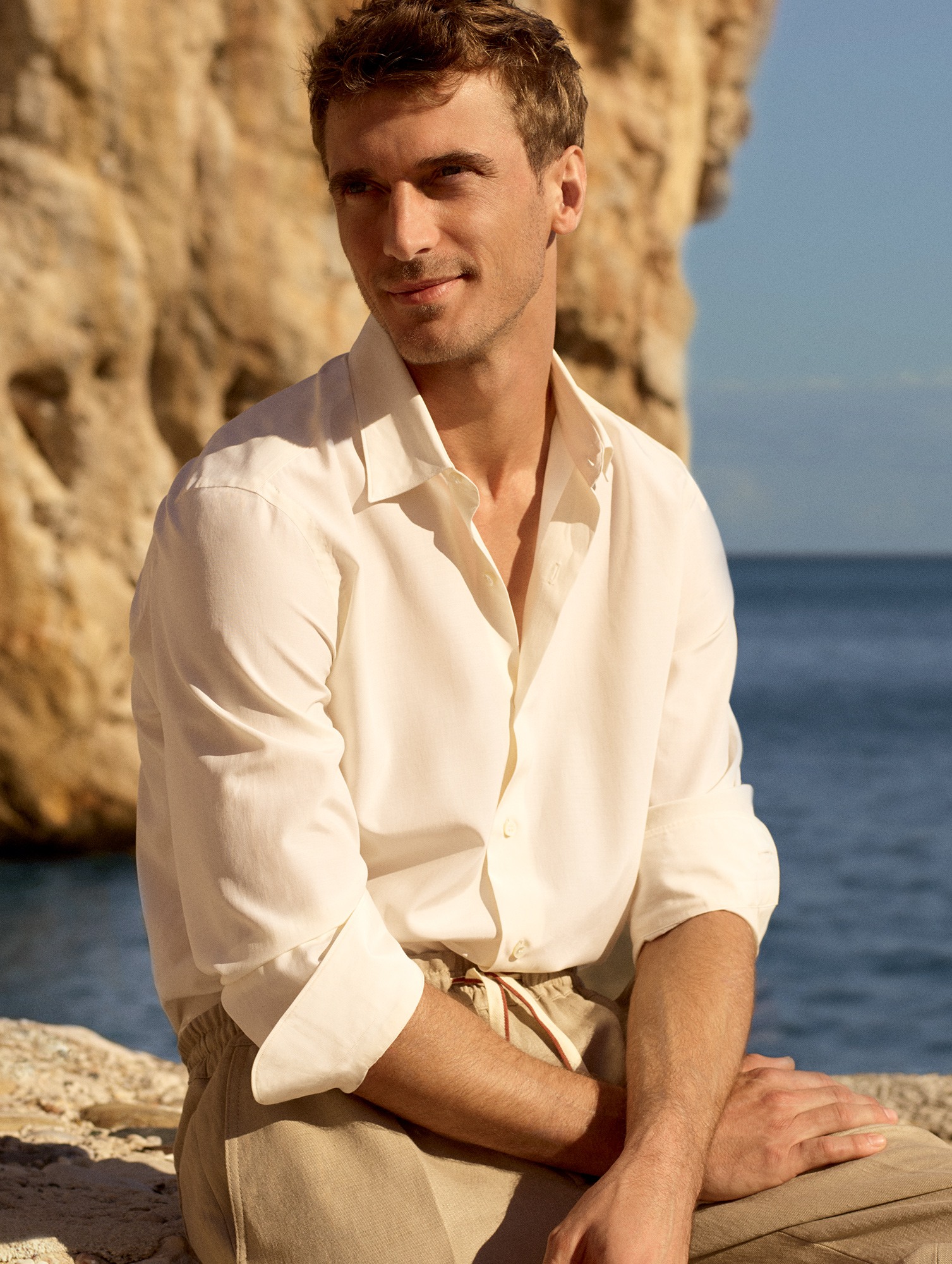
Interestingly, much of this is commonplace in womenswear.
As a friend and women’s stylist put it to me: “Women are so used to being told about simple white blouses, tucked into a fitted navy-wool trouser and patent flats. They're taught to think about these pieces of clothing separately, and moving them around as needed.
“The problem with men is they’re still rooted in the idea of the suit. They need to escape that and see every piece individually. Then it makes sense that you wear a blue shirt with an olive-coloured jacket, not a white one.”
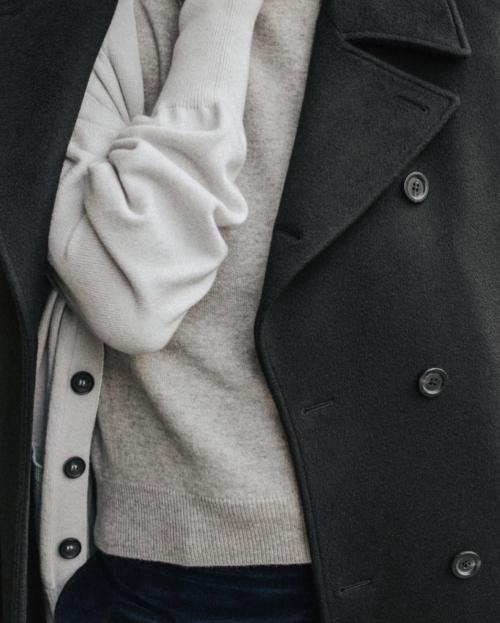
We were actually discussing the Classic Collection at Connolly, which is aimed at both men and women.
There aren't many things in that range that work for me, but it is an interesting insight into smart women’s clothing - and how many of the same ideas of simple, muted clothing, driven by proportion and fit, apply.
Perhaps another article on this topic could examine brands that do this well. The likes of Loro Piana, Saman Amel, Adret or Rubato. Even a brand like Margaret Howell, which is just as simple but with a different emphasis on materials.
And of course sportswear from the 1930s to 1950s, which was peerless for this kind of casual chic.
But perhaps for another time.
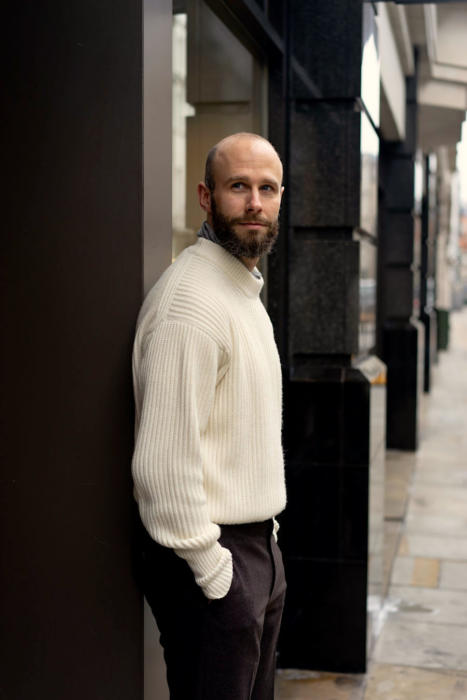




























Simon, thanks, another enjoyable read and a well-written record of what is largely an intuitive process, for me at least. If I may add an addition to the first rule: ‘ton-sur-ton’ can be a stylish lifesaver if you’re under time pressure, like myself this morning (that young-family-eye-of-the-storm-feeling). I was very happy to be able to grab my chinos and polo shirt – both navy, but slightly different hues – slide into my light-brown suede boat shoes, and know that it would all work together colour-wise.
No one in Tesco would have noticed anyway.
How do you feel about wearing casual jackets, like a Valstarino, for the purpose of looking smart without tailoring? I often find that “normal” shirts, standing alone, make the wearer look a little bland or naked., often revealing flaws in wearer’s body. I’ve found a casual jacket visually resolves these issues without increasing the formality of the outfit, and would be interested to hear what you think. Could you also recommend casual jackets other than the Valstarinio that would serve this purpose?
That can be good, yes Jason. The only issue I guess is that they are outerwear, so don’t provide much of a solution inside.
Other casual jackets that work in that respect, though, include smarter versions of suede jackets or suede or wool overshirts.
As much as I like layers, patterns, jackets, ties… I do indeed find that often a minimal outfit of plain trousers, plain shirt or t-shirt, and loafers or espadrilles is as elegant as it gets. It looks confident to keep things muted, and to avoid any accessories.
Hi Simon
Enjoyed the post today. I was wondered how you see formal raincoats fitting in with casual clothing. I wear casual clothing for work but would still prefer to wear a Macintosh and a good umbrella on a wet day
Paul
Interesting Paul, I hadn’t thought about it.
I can certainly see a roll neck and tailored trousers fitting nicely with a Mackintosh. But it’s harder with more casual clothing.
I think a cotton single-breasted might be good – like the long one I covered for Drake’s last season if you saw that? Cord detail on the collar
How would you compare the quality of cashmere of Luca Faloni and Connolly? I own several cashmere cable knit sweaters From LF which I like a lot (nocciola is particularly gorgeous). I don’t have anything from Connolly yet, and I’ve noticed the prices are often double those of LF.
From what I can tell, the difference appears to be primarily in the style: slouchy luxe from Connolly versus Italian chic from LF
The quality of Connolly is probably higher, and the Faloni is a fairly light gauge, so there’s less cashmere in it. Connolly does some very chunky ones too with loads of it.
I’d say the difference is less a particular style, and more the fact that Faloni just does basics, standards. Whereas Connolly is more original
Seems to me like there’s a big difference between the two brands in terms of style. Connolly appears to have a slightly Bohemian, artsy aesthetic that features luxurious fabrics and a very generous cuts. At least that’s my impression, based on some of the “Friends” that Connolly features on its website. The “art cardigan” is emblematic. The style isn’t for me, but I can see why some people like it. The pricing on their knitwear is expensive but not unreasonable, given the quality. (Some of Connolly’s other pricing seems exorbitant – e.g., their RTW dress shirts are more expensive than a bespoke shirt from Luca Avitabile.)
Personally, I find that Luca Faloni hits the sweet spot in terms of quality and value. I’ve seen companies charge twice what LF charges for knitwear of equal or inferior quality. As you put it, their emphasis is on “basics” and they’re all very wearable. It’s where I get many of my casual basics from. (Notably, their Lookbooks do not include a single picture of someone wearing a suit or sports coat, and do not feature anyone in the home or in a major city. All the pictures are taken on the beach or resort town or in the mountain.)
Nice point on the locations, yes.
Connolly has more variety, more design, both in each collection and between collections. If that is done well, it’s not cheap – it’s the one thing fans of classic menswear often underestimate about designer brands.
What gage would you consider heavy? Or light, for that matter? Thanks.
I’ll have to check again on gauges of different things, but the main point is relative – remembering some are finer than others
From a woman’s point of view this is the best article you’ve written.
Thank you Valentine
A very enjoyable read, Simon. In this day and age, there is a need for men to be properly educated on the art of looking smart in casual clothes. The quality and craft of your writing are the things I appreciate the most about Permanent Style. I’m looking forward to more posts on the topic of the permanent elegance of casual chic.
I haven’t been able to visit the Connolly shop in a while. Regarding their current range, the product that appeals to me the most (based solely on the product photography) is the navy mixed linen giubbino jacket. The material looks lovely, and the drawstring around the waist looks like clever way to convert this from a loose-fitting shacket into a blouson with a cinched waist.
Have you tried it on and if so, what are your impressions?
Hey
I have one and have covered it – https://www.permanentstyle.com/2019/08/the-fully-fashioned-t-shirt.html
Overshirts in a rather formal color can be very practical for dressing up without ever fearing to be overdressed. The simple fact of having an extra layer (over anything, really: shirt, polo, tee even…) is often sufficient.
True Gab, that’s a great first step. I think we’ll see a lot more in the overshirt/jacket substitute area in the coming years for that reason
Simon, did you ever commission one from Stoffa? Theirs is probably the cleanest one I’ve seen in recent time. I especially like the hidden side pockets. Depending on choice of material, I think it could cover most of the year in terms of usage.
No I didn’t, but good point. Their style, particularly the collar, is very well done
Simon, what´s your opinion of this 100Hands linen overshirt? thanks!
https://baltzar.com/products/100-hands/tobacco-brown-irish-linen-traveller-jacket/#!
It looks nice. There are a few things I would change ideally – and I prefer my Armoury one there, or the Luca Avitabile one. But it’s very much a question of personal taste.
Sage advice but don’t you think you are pushing sand uphill ?
The harsh reality is that the majority of men have had their sartorial antenna surgically removed at birth and have as much chance of looking elegant as I would of knocking Tyson Fury out in the first round.
I mention this because I suspect haunters of this hallowed cyber Hall know more or less what they are doing.
Those that don’t need a different approach.
A friend of mine who has been a sartorial Philistine from birth bugged me about this stuff for years, largely at his wife’s behest. I suggested everything known to man – all to no avail.
About 18 months ago I came up with the solution and it has worked a treat.
After another frustrating exchange I said to him ; ‘Look the problem is you’re not really interested in this stuff. Your wife is, you wish you were but you just aren’t. Let’s look at it another way. Is there a movie star you wished you look like ?’ ‘Yes’ he said in a heartbeat, ‘Cary Grant’.
‘Great choice. He has your build and colouring – let’s get every photo going of Grant going – put them on a mood board and with the exception of adjusting the cut as appropriate, you are going to dress exactly like him.’
He does, he is as happy as a pig in the proverbial and his wife loves it. He has even been promoted at his work.
I mention this because words like elegant and chic have no meaning to the 98% of men who are sartorially challenged. They will never be true flaneurs. Their only way forward is slavish imitation.
Thanks Jason, and nice example. For the general populace, yes such examples can be very practical.
But it’s simplistic to split people into two groups like that. I know from comments, questions and analytics that there are lots and lots of people that want more advice in this area – that want to dress well but don’t have good guidance. They’ve had nothing but fashion mags for a long time.
I’m never going to convince the majority of men. But convincing and enabling a few per cent is a huge achievement
El Flanario: Confessions of a Fashion Assassin
Simon, thank you for your thoughtful and specific guidance on a wardrobe subject that I struggle with constantly. A very helpful article!
Michael
Cheers Michael, I’m very pleased
Simon, is there a difference between this and what you call “Italian smooth”?
https://www.permanentstyle.com/2018/02/five-paradigms-of-casual-clothing-which-do-you-wear.html
Good point. It certainly has a lot in common with that look, or paradigm, but these casual chic principles are rather broader.
For example, you can apply some of them to workwear. I already mentioned Margaret Howell, but I also saw a Japanese guy last week looking rather chic in loose white coarse-linen trousers, an indigo T-shirt and navy sashiko jacket over the top. It certainly wasn’t smooth, but the simplicity of colour, lack of pattern and clean look made it the most chic version of that vintage/workwear look
I would be interested to hear your reflections on the impact of the current situation on Permanent Style – is this the death knell for the suit, are your readers focusing on articles like this to learn more about casual wear and disregarding the pieces on tailored clothing, are people commissioning bespoke now but only odd jackets for the autumn, are people retrenching completely given the economic uncertainty or still buying but with a different focus, and so on.
Thanks David, I’ll write something.
I think in short, there will be less suits but they were barely standard office attire anymore anyway.
And people are buying less, but still want to buy quality – which is what PS has always been about.
Finally, many men might resort to T-shirts and sweatpants to work from home, but someone that likes and enjoys clothes will not. Which is not the majority of men, but I think is the majority of readers.
As a relatively new reader of PS, I have to admit that I’ve historically not been a great fan of clothing in the PS sense, and in fact I’ve spent most of the last two decades in “scruff order” – working for a media company with a very casual dress code, then working from home for the last 10 years, my standard mufti was (sorry!) a pair of cargos, polo shirt and trainers.
I discovered PS around the same time that this look started to feel “not me” any more (possibly to do with getting older) and, while I may never invest in a bespoke suit, I have certainly sharpened up my act a bit. Ironically, and contrary to your point about resorting to T-shirts and sweatpants to work from home, since the COVID lockdown I’ve made a conscious effort *not* to “shlomp into scruff order”, and have been making sure to get up and dress in “smart casual” clothing to go to work (from home) – even if it’s e.g. only a pair of reasonably well-fitting chinos, a nice button-down Oxford shirt and a pair of comfortable leather shoes. (the shoes make a disproportionate difference)
Sticking to something a bit sharper, in terms of clothing, has made a significant difference to how I’m coping with the current situation – my partner has been shielding due to health issues, so I’ve effectively been in lockdown since late February; feeling “put together” for work has had a major elevating effect on my mental state. And I’m definitely keen to continue and to “up the game” further as time goes on, even with the current uncertainty, because of how the change in dress makes me feel.
Any thoughts on more casual footwear, especially in summer?
For now I’m a lot more casual at work, but trainers aren’t appropriate. I struggle with the fit of loafers (unless there’s some hidden elastic- which isn’t usually a mark of quality footwear!)
Some round toe double sole boots or brogues work well most of the year, but in summer it seems wrong and can be too warm, although if you could recommend an unlined brogue that could be interesting.
I should also qualify that having read your article the issue could be the choice of trousers and I will actually invest in some better fitting/MTM casual trousers. I think a slimmer shoe often looks wrong with a more ‘relaxed fit’ chino.
The best I can come up with are unlined chukkas. Any advances?
There’s actually a piece on ‘my summer shoes’ coming next week… Look out for it
I’m going to guess unlined Belgian loafers (Baudoin & Lange Sagans – no surprises about that one!), suede boat shoes (Polo RL), espadrilles (Drake’s), unlined suede chukka (EG Shanklin) and then a goodyear-welted loafer (maybe from the G&G Fresco line for more summery or perhaps G&G Classics line for something a little more year-round). Interested to see …
You’re pretty close…
Hi Simon
I think this article takes on great relevance in home office times and zoom mettings. Where wearing a suit o tailoring seems affected and misplaced.
In my case I have found very useful the shawl cardigan. I use those of anderson and sheppard in four diferent colors, wine, navy, light brown and bottle green.
I think that the key there is the deep lapel and low buttoning point that provides the lapel effect from a tailored jacket.
I find that it elevates the outfit to similar levels of an odd jacket in terms of elegance but maintaining a much more casual look.
Also I see that it fills the parameters you review in the post.
Simon, Do you think there’s another similar garment that’s so versatile and useful?
thanks in advance,
Dan
Thanks Dan.
If suggest the linen overshirt, perhaps as a summer equivalent?
I know they’re not your cup of tea, Simon, but I find the Teba jackets to be a good shawl cardigan – overshirt hybrid.
Good point Hugh, yes
Great article. Many thanks.
Where are you standing, Simon? Is that London? No hat?
At the bottom? Outside our pop-up shop on Savile Row. Hat was a watch cap sitting in the pocket of a coat indoors
I’d just like to point out something else: all of the clothing pictured above has clean, long flowing lines. Everything fits a little more loosely and is a little more drapey, kind of like old school tailoring. Nothing is very tight. The leg lines aren’t broken by fabric catching on the leg. Hem lines are a bit wider, and shirts a big baggier. Everything recalls vacationwear you might see in an older movie.
Good observations.
What goes around, comes around.
Things have been loosening up for a while.
It’s no longer de rigour to be trussed up like a ‘Piti Peacock’ – thank God !
Great read Simon,
Could add stoffa to the list also.
I know u’ve done plenty of articles on capsule wardrobes recently. What would be your take on the capsule casual wardrobe in terms of shirts, trousers, outwear, knitwear etc.
Something like blue Oxford, white Oxford, denim for shirts.
Knitwear – Navy crewneck, Oatmeal v neck, Grey crewneck
Outwear – Overshirt, Grey raglan coat, Navy polo coat
Trousers – Grey flannel, Beige Chino, Olive Linen
Would be cool to see something related to someone who has no need for tailoring per say but still wants to look elegant
Hey Ricky,
Yes good point on Stoffa, absolutely.
On casual wear, I’ve done one. Look up ‘Weekend wardrobe’
“A well cut white shirt and linen trousers” – what linen have you found in your experience best for tailored trousers?
Irish linen, 11oz or so. It’s the linen offered by most British mills – W Bill, Holland & Sherry and so on.
See the Guide to Linen for more.
Thanks, Simon.
Favourite colour?
Cream, then olive, then tobacco
I really enjoyed this. I thought that every menswear topic had been covered, but you’ve written about something new that I really don’t recall being covered here or elsewhere. I know you’ve presented some of these ideas before, but this ties everything together nicely.
Very mixed feelings about this article.
On one hand, it will certainly be useful to many fellows who want to dress better but feel they should dress down.
All the points are well made.
On the other, it feels a lot like yet another concession to the contemporary rage for removing any sense if occasion, tailoring, formality from clothing.
I feel like five years from now I’ll be reading a well-written, well-researched PS article about looking good in pajama bottoms, crocs and a string vest because they cost 2 grand and are made by Cucinelli…
I can understand your hesitancy, but propriety and indeed style in clothing is a social thing. You don’t have to sink to the bottom, but you can’t be completely out of time and place either.
I’ll always be aiming to present the best way to remain elegant in quality clothing, whatever the current social mores.
Hopefully that will never get to string vests.
And we’ll certainly not be recommending ones that are just expensive because of a designer name. We never have.
They must be hand-spun string vests, made by a heritage vest maker, in the highest quality Italian string.
Insert smiley face.
The last sentence of the first comment made chuckle. Your reply made me burst out laughing
Thanks to you both!
Simon — much of P. Johnson seems to be in this vein to me. Thoughts on where you see them versus some of the other brands you mention? Also, MTM knitwear seems to be trending a little and feels like it’s important as part of the casual chic conversation. Curious for your thoughts on it too.
I’ve always liked the P Johnson aesthetic, yes. Some of it is a bit sloppy for me, but the outlook and colours are bang on. Have you read my previous articles on them? Details on these points there
On MTM knitwear, I think it’s a minor point here, in that it only matters to the fit point, and only if you can’t find RTW knitwear that fits well on you
Nice article, Simon. Thank You!
You emphasize the importance of muted colors. However, you’ve also mentioned in the past how you can’t resist being inspired by Ralph Lauren. RL has always played around with the Ivy/Preppy American traditions, in which stronger and brighter colors certainly play a role. It’d be interesting to hear your opinion on that.
Hey.
You’re right, and that Ivy look would not be as chic – it would be more casual.
However, it’s also worth noting that RL does a very wide range of looks, and Purple label is often very tonal. Lots of charcoal and cream, camel and tan, navy on navy and so on
Thank You for the reply! Yes, certainly RL has done many different “looks”, my personal favorite being the “Safari” from the 1980’s. It’s a pity, Ralph doesn’t design movie costumes (Great Gatsby, I believe, was his only attempt at that back in the 1970’s). I guess, my question is, would you consider the use of brighter colors in casualwear, to not be elegant in general? What about Indian madras, pastel shirts in shades of pink, yellow, or lavender? Your opinion on Nantucket Red?
In general, the colours will be less casual, but pale pinks and yellows are still pretty smart – whereas madras is less smart because it’s a strong pattern, rather than being coloured
Nantucket red is a fairly strong colour, but less so the more faded it is obviously
Do You think that men will wear ties again? I’m recent times and for obvious reasons, it’s only been the politicians I’ve seen wearing them.
Not often, no. I think more knitted wools and silks. And perhaps as a way to dress up jeans etc.
Also, perhaps, as a smart option to formal events, replacing black tie.
Simon, if men won’t often wear ties – what’s the best sort of shirt to go with a blue suit in the office – let’s say a blue fresco suit. What type of collar works do you think – button down perhaps? And colour – blue or white or grey? Plain or stripes? We all need to avoid the dreaded same blue suit with a white opened necked shirt
I think pattern, definitely. Stronger stripes, shadow stripes, and colour if you can. Pinks, greys, yellows. Perhaps grey too
And either button down or spread collar, as long as it sits out proud from the lapels of the suit
The politicians?…….Oddly they seem to be the main proponents of the false and limited assumption that wearing a tie is a deeply conservative act. Usually they seem to uniformly take them off together as if (rather patronisingly) this makes them in tune with the common man.
I’m afraid I won’t be taking any social dress cues from Mr Johnson! It’s obvious he’s not in the least bit a reader of this site.
This is one of the most thought-provoking, useful and well written articles I have read on any menswear site. The writing is really exceptional.
Thank you and congratulations, Simon!
Outside of the summer months, a great casual look is to substitute shirts for knitwear – wearing the knitwear either by itself or under a tailored jacket.
I have several cashmere sweaters from Luca Faloni that I get a lot of use out of. I find the cashmere to be excellent quality and an all around good value.
On the cheaper side of the spectrum, UNIQL’s Extra Fine Merino Woo knitwear is pretty good quality, and shockingly so for the price. I’ve gotten several thin merino crew neck sweaters and several thin merino long sleeve polo shirts from them. I avoid their cashmere (it’s cheap but doesn’t last very long, and is noticeably inferior to Luca Faloni – hence the price difference, which is justified IMO) but the merino knitwear is good value for someone shopping at the lower end of the price spectrum. As you pointed out in your review of merino knitwear, there are differences in quality between UNIQLO and finer brands – the question is to what extent they matter to you.
Good article Simon. May I suggest a seven? Shoes. Your choice of shoes can have a massive impact on how smart or casual this style of clothing looks. But I would say that, wouldn’t I?
Hello Simon,
I am a longtime reader of your blog, and would like to thank you for your many interesting and very informative posts. I have learned (and continue to learn) a great deal here.
As already touched upon in the previous comment by I.T., I would like to challenge the notion that elegance is defined by muted color choices. I don’t dispute the effect of muted colors as you describe it, but I think that part of this stems from an arbitrary and at this point perhaps largely obsolete cultural norm that equates reserve and uniformity with masculine elegance and dignity. This standard appears to me to have its origins in modernist ideas of merging form and function, shedding all frivolous and unnecessary ornament. This is an idea that, at this point, is 100 years old. Further, men at that time (at least those that could afford to) had the option of more colorful daytime dress that was both elegant and more expressive in color; one need only think of Gatsby’s “pink rag of a suit”, or the scene in which he throws down his shirts.
The scope of acceptable color ranges and cuts in men’s non-streetwear fashion seems to have shrunk dramatically over the years, and settings in which formal clothing (and the dramatic effect of the strictures of style and palette they produce) have largely vanished. What we appear to have been left with are navy, gray or tan suits without ties, navy, gray or tan trousers, and navy, gray, or tan shirts; “style” has become fussing over buttonholes and lapel widths. While I certainly enjoy a bit of fussing myself (why else would I be here ;-)), it also seems to me that these details can make an article of clothing just as “loud” as any color. (styles of shoulder pads/roping, shoes with such pinched waists and points that they appear to be straight from an early 19th century drawing, etc.).
In the absence of frequent formal/informal dressing opportunities, wouldn’t it be good to revise the definition of “chic” to allow men to wear a more color? In previous centuries, after all, an elegant man wore a richly embroidered waistcoat or a scarlet doublet. I think more men would enjoy getting out of their jeans more often if they didn’t feel they had to confine themselves to the same old “workwear” colors in order to seem stylish.
Hi Willy,
Thanks for the insightful comment, and I’m very pleased you’ve found the site so useful.
I disagree, slightly. I think on the one hand, more discreet uses of colour and pattern will always be more refined and chic – that doesn’t mean it has to be all navy and grey, but they will always tend in that direction.
And second, much of this is very cultural and social. These more muted, plainer colours are simply seen as more elegant by most people. It’s an observation, not a decision. The association probably is outdated, as you say, but it still pertains in most places, and there’s little we can do about it.
Thanks again
Seems to me that “elegance” encompasses both objective and subjective considerations.
Objectively speaking, certain colors tend to go better together than other colors. And looks that make people look taller or longer tend to be more attractive than looks that make you look shorter, that shorten the neck, etc. In women’s fashion, looks that are sensual tend to be more elegant than those that are raunchy. And so on and so forth.
“Elegance” also has a social component, which is more subjective and arbitrary. This requires being able to recognize what sort of attire is appropriate for a particular situation, and when possible, to elevate that. For instance, three piece suits can be very elegant, but there is nothing elegant about wearing a three piece suit to a barbecue. The elegant thing to do is to try to wear attire that is appropriate but dressy – e.g., a linen shirt instead of a grubby T-shirt.
Aside from the aesthetic considerations outlined above, elegance – particularly for men – entails a degree of modesty / not seeking to be the center of attention. There’s nothing elegant about dressing flamboyantly or in such a way as to unduly attract attention. That’s why (for men at least), muted colors tend to be more elegant than loud colors. (Social conventions for women, particularly younger women, are different – when gentleman takes a lady to a dance, the convention is for the lady to wear brighter colors and for the man to wear a dark suit or tuxedo to avoid upstaging her).
I’m not necessarily endorsing all of these conventions, but they are what they are.
I’ve been waiting for an article like that. It’s a shame that there really is no place to wear the cool 30’s style outfits, but I can live with it. Since somebody already asked about “Italian smooth”, my question is: are there any ways to bridge your idea of casual with Ivy? A lot of the pieces overlap – oxford’s chinos, loafers, basic white sneakers. But Ivy tends to be presented as the style of worn out, battered clothes, function over form and so on. Quite similiar to workwear in that approach.
Yes, there are certainly more refined versions of Ivy. You lose a lot of Ivy if you always dress like that, but someone who likes that style could easily turn to a blue oxford, navy shetland, neat stone chinos and cordovan loafers, when they wanted to be smarter without tailoring.
The clothes can be worn and battered, but they can still be well cut, simple and clean
How does your consultancy service work? Thanks.
Sometimes readers want to chat about questions at length, or do something in depth like plan building a wardrobe of clothes. They ask to chat in person or (more often) on video chat. Send me an email if you’d like to talk about that more
Simon,
Is your jumper “tucked in” your pants in the final photo?
Looks rather bulky to be successfully accomplished, or at all comfortable, if so…
No, I never tuck in knitwear. It has ribbing that means it doesn’t need to be tucked in, as well as indicating it’s functionally not meant to be.
The only interesting area for that, I think, is T-shirts, which were made to tuck in, but which are almost universally untucked. Tucking in the right cut and weight of tee can be interesting
Have you tried Stoffa’s cashmere knitwear? The chunky design with the oversize ribbing looks interesting. And the color palette also looks nice.
Ive tried it on, yes. It was cut rather short in the body for me – really best for high-waisted trousers. Quite expensive as well
The scarves also seem expensive (at $375), and their sunglasses even more so (at $600). You’re not paying a premium for the brand and I’m skeptical that the construction / materials / design merit a $600 price tag. But hard to say without seeing in person.
Would you say that their best offerings are their trousers and outerwear?
To be honest, I wouldn’t be as sceptical on the value front. I think a lot of the value with Stoffa comes from the original fabric development and designs. It’s more a question of whether those individual designs and fabrics appeal to you
Right, and that’s impossible to discern without seeing a trunk show in person. Based on their product photos, I really like their color palette.
Look forward to attending one the next time my business, which unfortunately may be awhile, for obvious reasons…
Thanks for the responses!
What about their rollable hats, do they work well and is the quality good?
I have a nice hat but it doesn’t travel well. I’ve been searching for a good that rolls but haven’t had much luck yet.
I haven’t tried one I’m afraid
A fantastic read; for me, a reminder of what I suppose, in the wider context of permanent style, might be considered the ‘new’ fundamentals. But of course, like all the best things in style, the principles are timeless. I particularly enjoyed the more thematic and abstract images accompanying the meditation. I find my camera roll is increasingly full of found images of outfit inspiration from lookbooks and blogs. Your proposed roundup of brands in this casual elegance category would make a wonderful follow-on; I also lingered on the point about mid-20th-century sportswear. Would some historical pieces covering such design movements in more depth be of interest to the readership?
Thanks Josh, and nice prompts to follow-up pieces, yes.
Lovely article Simon.
I just cannot refrain from saying that relaxed elegance is achieved via a learning process that takes time. If you were lucky to have well dressed grandfather / father / uncle you will always be ahead of the game like those who start playing their sport when they are very young.
I imagine that must be completely correct, yes.
We all know how to wear suits from seeing them around us, on family and on colleagues. Unfortunately we haven’t seen that kind of chic casual on people for quite a while.
This is an interesting and very timely topic indeed. Summer tends to be more dressed down in general, and the current situation hardly helps in regards to wearing tailored jackets or suits.
I have gravitated towards this look for some years now, balancing neutrals with navy and grey in casual as well as tailored clothing. What looks good is subjective of course, but it makes life much easier when getting dressed.
I’ve found good knitwear is vastly underrated and having them locally, I swear by Saman Amels knitwear program, the merino in particular.
It’s also highly practical, as you can easily swap out the shoes and throw on a jacket and be ready for most situations safe for weddings, funerals etc. I’m at the office right now in tailored summer weight beige cotton slacks, navy long sleeved crewneck and a navy overshirt, with snuff suede sneakers. Both shoes and overshirt could be swapped for loafers and proper jacket for an impromptu customer visit, unlikely as that would be at the moment.
Having said that, I wore a tailored jacket and tie this weekend and it was a lovely feeling indeed. I’m sure I’ll gravitate more towards casual suits and jacket/trousers combos come fall, but this will always be a very nice foundation.
PS. I would love to read some follow up posts on brands that does this well. Could be a very nice tie in to the piece on your own Loro Piana items picked up over the years, that you mentioned years ago. (Although those wouldn’t necessarily all fit into this category of clothing).
Simon, I wonder if either you (or anyone else) could explain what’s behind the terry cloth trend. After easing your article on the “Summer Top Five,” I visited The Anthology’s website to look at the Tee you featured and couldn’t help noticing the Lazyman jacket – and the fact that the navy variant is made of terry cloth, a textile I had always associated with bathrobes and pajamas. I’d never heard of The Anthology before, so I just chalked it up to eccentricity of a relatively new company.
After that, I checked out Connolly’s website. In contrast to The Anthology, I was already familiar with Connelly. I’ve visited the store several times and purchased one piece of knitwear. So you can imagine my surprise, when in the course of browsing the summer collection of this venerable company, I noticed that it is hawking an array of Tees and long sleeves polos – made out of terry cloth, of all things!
What’s behind this? Is there anything special about the properties of terry cloth or are they doing something different with it? Have you purchased anything made of this wonder-textile yourself?
It’s been around for a few years – Drake’s did them a couple of years ago, Orlebar Brown have done then for a while, and so on.
It’s a fashion, but also a heritage style, and practical to put on when you’re by the pool on holiday. I wouldn’t really wear it much in other situations though
What do you mean by “heritage style”?
It’s a style with some heritage. It’s not just a new piece of fashion that has been dreamt up, but something that was worn more widely in the past.
To paraphrase a comment from JJ Katz (above), it’s only a matter of time before we start seeing a well-researched article about a strong vest made by an Italian heritage vest-maker, out of the very best terry cloth string…
In fact, I haven’t checked out Bruno Cucinelli in some. I wouldn’t be surprised if such a vest is already available 🙂 the future is now!
Hi Simon, as to looking smart without a suit, is a restock of the PS PWVC Donegal coat planned for this autumn?
Hey Gab,
Nice segue. Yes, it will be back in September. Slightly different colour, which I love, and slightly heavier weight.
Generally people email the Support team for info on upcoming products, and there’s a waiting list run through that, where people on it get alerts when things come in. And before everyone else. Email [email protected]
Thanks Simon, email sent.
For a casual chic look: no pleats or one pleat?
Either can work
How does this apply to warm climates? What materials and pieces pair well? Any recommendations on stores for this style?
There’s no difference with climates really – see Adret styling on Instagram as a specific example. That’s pretty much all warm-weather clothing.
And don’t go just to specific brands with this – focus on the principles instead. Almost any brand will sell you something that could work here
Alan Flusser says you shouldn’t look rumpled but in some of your pictures shown the shirts are like that and I think it makes the look more casual. I think the rumpling also works well for jackets to dress them down. How can I achieve this rumpling on shirts and jackets without making them look bad? Do they have to be linen to look elegant? Does picking a lighter cloth help to achieve this effect? And does removing all structure in a jacket help as well?
Interesting question.
I think you probably have to distinguish between rumpling that happens because of the materials, and because of the fit.
You can certainly have more casual materials, that will wrinkle more easily, and look more casual as a result. Most things you think of as more casual will do this naturally – linen, cotton, most lighter materials in general, but also soft tweeds.
I would be careful about aiming for rumpling from a fit that isn’t right, but at the margins it can be nice, for example a shirt that is a little more blousy in the waist, tucked into a neat waistband.
It is my impression, that the most challenging aspect of this approach is the footwear. It seems that footwear is the one principle missing from the article. Could you speak to this?
I think you’re right, it is a hard area to do well. I would say most good shoes for this exist where the smartest trainers meet the most casual shoes. So suede loaders and boots, but also clean slim trainers and canvas tennis shoes.
Is there a possibility of even a very casual outfit such as dark wash jeans and a button down down shirt to look fussy and if yes then how to avoid looking like that in it?
I thought fussiness was a problem only with formal outfits.
It certainly can happen, but it’s a much smaller risk.
Things that help are when the clothes look worn in, eg fades on the jeans etc, personal ways you wear them like rolling your sleeves up, and just being quite relaxed and comfortable!
So maybe instead of wearing dark wash jeans should i go for mid wash which would then look unfussy?
I don’t think the jeans wash would make much difference. Just wear the jeans more so they look worn in
Simon, thank you for pointing me to this very helpful article.
One issue that strikes me is that many I know – usually below 40 to 45 – would like to replace the classical jacket/blazer, finding that the style is somewhat outdated (this includes unstructured jackets in cotton, linen etc), but still want to look good/smart. What in your opinion could be a more casual replacement (cardigans, safari-jackets, overshirts, something else entirely?).
You mean for the outerlayer? If anything that looks even vaguely like a blazer is too much, then I would say overshirts, yes, and good knits with coats in the winter. Or chore jackets, or Teba styles. Perhaps this is worth a separate post?
Thank you Simon. Somewhat difficult to answer for me as the categorization in Germany/Austria seems to be quite different than in England. I give it a try.
I did not mean jacket (in the German sense of the word “Jacke”), which is something only worn outside and can range from a down parka (for very cold wheather) to a cotton-linen blouson / Harrington jacket (for warmer wheather).
Rather I meant a replacement for a blazer / jacket (in the English sense), which is also worn inside (e.g. an office, a restaurant), which is one of or perhaps the main focus of your website. It can, of course, also vaguely look like a blazer / jacket (in the English sense), without having the connotations (at least in Germany / Austria) that often goes with it – even if it is something like a Boglioli K-jacket – such as being somewhat old fashioned and to be worn mainly by older people outside of the workplace who are also politically conservative (this at least can be the connotation in the German speaking world).
Yes, I think a post along this lines “How to replace a jacket” would be very interesting but of course you are in a much better position to judge.
Great, good to know Markus
A short PS: I also mean something somewhat smarter than knitwear, excluding the (shawl) cardigan (which I find to be a replacement of a blazer/jacket but only in winter.
Understood. Thanks Markus
While I’d also be happy to get inspiration for contemporarily smart but not overly formal office wear, I wonder what kind of magical new category of garment Markus might have in mind: There simply is no real “replacement” for a blazer or other tailored jackets.
For me it’s quite straightforward: During summer I would just wear a shirt, and otherwise I would add some knitwear. Usually this will be a fine merino sweater, as I find most cardigans to look a little sloppy (as in, not professional). There are completely unstructured jersey blazers that kind of work as middle ground between tailoring and knitwear, but that’s about it. Overshirts etc. to me look way more casual than the shirt/sweater combo, and I would never wear them in the office.
Of course within these parameters there is a lot of room for playing around with colors, textures, cuts etc., which you address in this article.
Hi Simon,
What do you think of the shortness of many of Drake’s tweed blazers. Also, what is your opinion of their habit of styling shirts and ties without jackets (and in place of jackets army coats or cardigans)?
Cheers,
Michael
I like the second style, particularly if it means you find a way to wear a tie.
On the length of jackets, see video here.
Thank you for the video mate, great watch. So you wouldn’t find wearing a Barbour jacket with a shirt and tie but no jacket uncouth?
No, not necessarily. Helps a whole bunch if it’s well executed
Hi Simon,
I was wondering how a pair of a heavier medium grey Irish linen, maybe 12 or 13 oz, work in terms of formality within casual chic? Thank you in advance
They would be great Kyle. Wear in warmer weather in the same way you’d wear grey flannels – with white, navy, dark brown, black
Can a fully fashioned t shirt look affected when worn on its own as I have been reading in a lot of comments?
It’s certainly a touch unusual, but I don’t think it really looks that affected, no. If you’re concerned, try it in a very normal colour, and wear it in a average outfit too
Hi Simon, thank you for this article. It’s been so helpful to better understand the principles and associations for this style. I noticed many of the staples of this style are summer items – linen or cotton trousers, polos, etc. Do you think there are any staples for a fall/winter casual chic? I see the use of knitwear in this article too, but wondering if there’s anything specific you would identify.
Yes absolutely, this can work just as well in fall/winter. Knits as you mention, simple coats (eg single breasted, maybe raglan) but in sophisticated materials. The two Saman Amel images here, all three Connolly ones, plus Miles in his roll neck and loose flannels
One more thought (following on my comment a minute ago): I find the principle of relying on colder/muted colours really helpful. I naturally like more muted combinations, and in this style it seems especially important (as you so clearly articulated). I find myself using a simple mental shortcut related to this. I assign a value between 0 and 1 to all the colours in an outfit, with 1 being very rich or saturated non-neutral colour and 0 being totally neutral. Then I try to have the sum of the outfit be < (or equal to) 1. Probably excessively analytical, but I find this usually helps remind me not to do too much through colour and I’m usually happy with where this thinking leads.
Do you prefer incuding elegant pieces even in your casual or workwear outfits?
I do both Tamesh, sometimes mixing it up and sometimes wearing much more similar pieces together